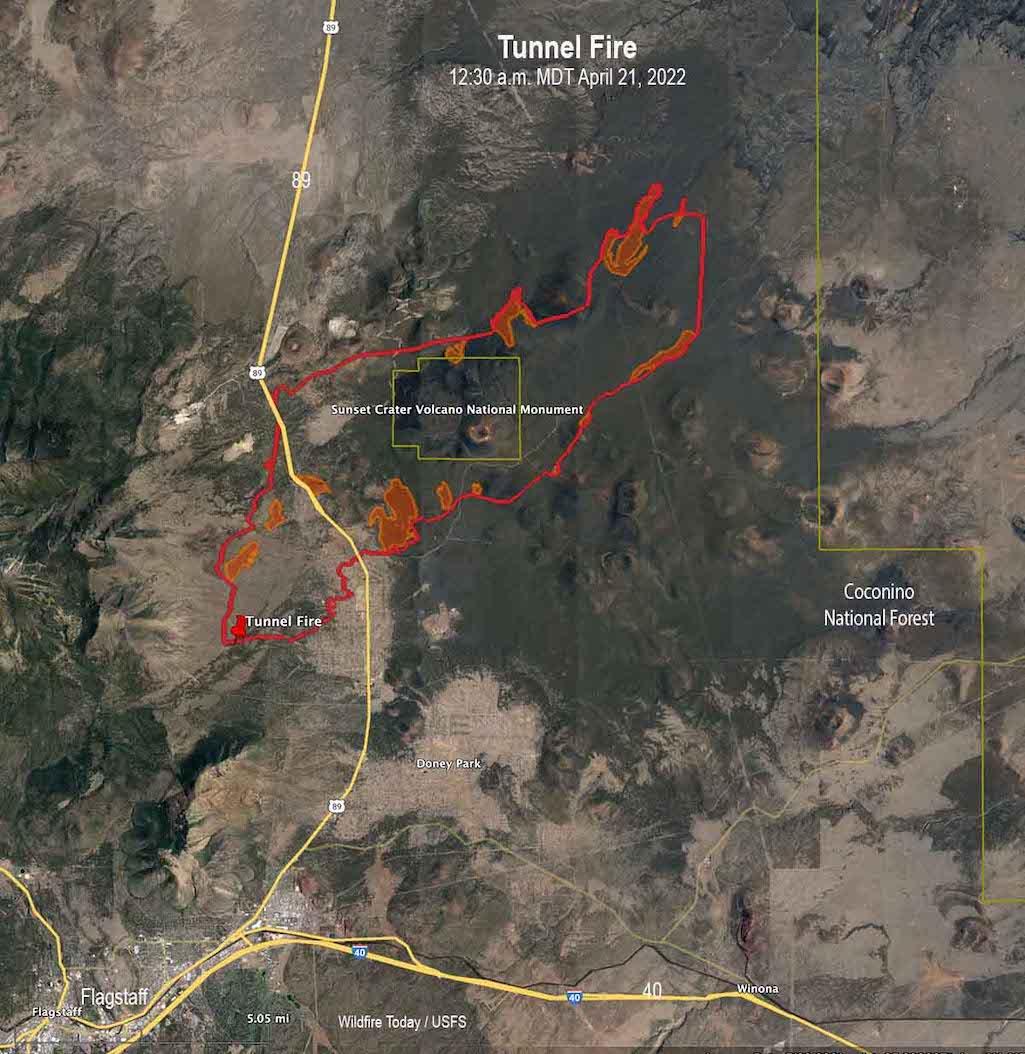
The Tunnel Fire enveloped Sunset Crater Volcano National Monument/USFS
As wildfires go, the Tunnel Fire that overran Sunset Crater Volcano National Monument in April was not headline-grabbing outside of Arizona, but it inflicted enough damage on the monument and surrounding national forest lands to keep the monument closed for months.
Currently, the plan is to reopen Sunset Crater on August 17, but hundreds, if not thousands, of potentially hazardous trees are expected to restrict where visitors go in the monument.
"Hundreds of feet of guardrail melted along the park road," said Richard Ullmann, the National Park Service spokesperson for Flagstaff Area National Monuments. "This was a big fire. There are thousands of hazard trees that are in the process of being dropped. We can reopen in some sort of phased way starting on August 17. The park won't be fully open. That relates to for example, the Lenox Crater Trail. Nobody's dropped trees on that yet. The whole hill burned up, so I don't perceive that trail being open for a long time while we continue to mitigate risk. It's a complete burn-over."
The Tunnel Fire was spotted during the afternoon of April 17 about five miles north of Flagstaff. Two days later 50 mph winds pushed it across U.S. 89, and the flames then whipped over the 3,038-acre national monument. While fire maps showed Sunset Crater fully within the Tunnel Fire's perimeter, later mapping showed that 60 percent of the monument (1,814 acres) was burned.
"This fast-moving, wind-driven fire had a relatively short residency time and resulted in a mosaicked burn pattern predominantly consisting of low burn severity, with dispersed pockets of unburned and moderate severity," noted a Burned Area Emergency Response team that surveyed the fire's impact on the monument. "There were no high burn severity areas identified within the monument."

Potentially hazardous trees along the Lenox Crater Trail and the Sunset-Wupatki Scenic Loop Road/NPS
Nevertheless, the fire greatly impacted the monument's roads and forests, as well as the surrounding Coconino National Forest and its Bonito Campground near Sunset Crater.
- Nearly one-mile of guardrail along the Sunset Crater-Wupatki Scenic Loop Road needs to be replaced.
- Nearly 8,500 linear feet of the Lenox Crater Trail needs to be repaired (the trail tread was damaged, and logs that had been used to delineate the trail burned and need to be replaced)
- Traffic and informational signs burned in the fire and need to be replaced.
- Thirteen-hundred feet of split rail fence designed to keep visitors out of sensitive areas burned and needs to be replaced.
- One-thousand feet of barbed wire fence needed to keep livestock and ORV traffic out of the monument needs to be replaced.
- Nearly 1,000 potentially hazardous trees will need to be addressed (possibly cut down) over the coming three years.
"The visitor center was saved, the housing area right behind it was saved, but behind the housing area were our maintenance facilities, Conex boxes, equipment, gear, that all burned," Ullman said this week during a phone call. "We lost about a half-million [dollars] in gear for example, equipment. There's a large-scale, long-term effort to recover from what happened."
According to regional Park Service staff, agency resources from other Flagstaff area park divisions, as well as other NPS units and central offices, have been assisting Sunset Crater Volcano staff in multiple ways throughout these events. Specific examples include:
- A Burned Area Emergency Response team assisted with a post-fire impact assessment that resulted in resources and funding allocation;
- Grand Canyon and Forest Service crews have been working to cut and clear hazard trees;
- Experts from the regional office have assisted with environmental remediation;
- Engineering and project management staff from the regional office and other units have been assisting with assessing and replacing damaged roadways and maintenance facility infrastructure;
- During the fires, subsequent flooding, and cleanup, the NPS has also received significant support from the Forest Service, as well as other partners including Coconino County and the State of Arizona.
Sunset Crater was designated May 26, 1930, by President Herbert Hoover after a movie company proposed to blow up part of this unique geologic area, which features two cinder cone volcanoes -- Sunset Crater and Lenox Crater. The two are among an estimated 600 cinder cone volcanoes once powered by a maze of magma plumbing flowing out from the San Francisco Peaks, which are the remnants of a stratovolcano. Sunset Crater is the youngest of the volcanoes in the 1,800-square-mile San Francisco Volcanic Field.
Along with the geological aspects of the park, there are a few hiking trails, though much of the rocky terrain is sharp, brittle, and unforgiving. The Lava Flow Trail is a self-guided, one-mile trail, while the Lenox Crater Trail is a steep one-mile trail, and the Aa Flow Trail winds a quarter-mile through the lava flows. If you want a long hike, there's a trail that runs seven miles to the top of O’Leary Peak, accessible from U.S. Forest Service lands.
When those trails will reopen remains to be seen.
"We're looking forward to serving guests as best we can," Ullmann said. "There'll be limited services, there'll be limited access based on just the magnitude of what's happened, which becomes self-evident once you get in the park."



Comments
It's reopening next week on the 17th.